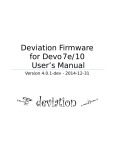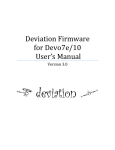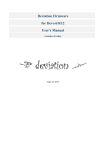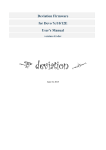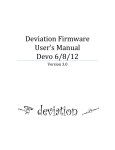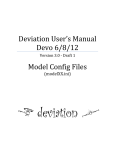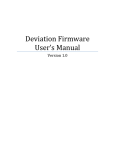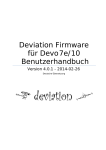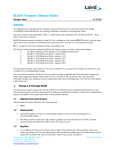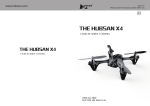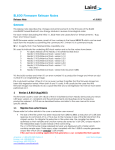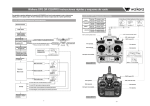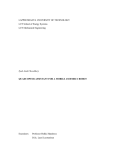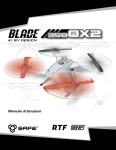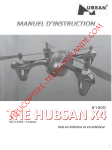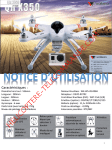Download Deviation User`s Manual for Devo 6/8/10
Transcript
Deviation Firmware
for Devo 6/8/12
User’s Manual
Version 4.0.1-dev - 2014-12-31
Deviation User’s Manual for Devo 6/8/10
Table of Contents
1 Overview...........................................................................................................................5
1.1 Disclaimer.................................................................................................................6
1.2 Notices.......................................................................................................................6
1.3 Legal status and copyright.........................................................................................6
2 Installation.........................................................................................................................7
2.1 New installation.........................................................................................................7
2.2 Upgrade notes............................................................................................................9
2.3 USB & File-system...................................................................................................9
3 Reporting Bugs...............................................................................................................10
4 A Note About this Manual...............................................................................................10
5 Main Page........................................................................................................................11
5.1 Safety System..........................................................................................................13
6 Navigating.......................................................................................................................14
6.1 Navigating with the physical buttons......................................................................14
6.2 Menu Layout...........................................................................................................15
7 Transmitter Menu............................................................................................................16
7.1 Transmitter config...................................................................................................16
7.1.1 Generic settings..........................................................................................................................17
7.1.2 Buzzer settings............................................................................................................................18
7.1.3 LCD settings...............................................................................................................................18
7.1.4 Timer settings.............................................................................................................................18
7.1.5 Telemetry settings.......................................................................................................................18
7.2 Channel monitor......................................................................................................19
7.3 Input Monitor..........................................................................................................20
7.4 Button Monitor........................................................................................................21
7.5 Telemetry monitor...................................................................................................21
7.5.1 USB/About.................................................................................................................................22
8 Model menu....................................................................................................................23
8.1 Model setup (Std & Adv GUI)................................................................................24
8.1.1 Predefined Model Templates......................................................................................................27
8.2 Mixer (Adv GUI).....................................................................................................28
8.2.1 Channel Reorder.........................................................................................................................29
8.2.2 Channel configuration................................................................................................................30
8.2.3 Virtual channel configuration.....................................................................................................31
Deviation User’s Manual for Devo 6/8/10
8.2.4 Simple Template.........................................................................................................................32
8.2.5 Expo & Dual-Rate Template......................................................................................................33
8.2.6 Complex Template......................................................................................................................34
8.2.7 Cyclic..........................................................................................................................................35
8.2.8 Reordering Mixers......................................................................................................................36
8.2.9 Available Curves.........................................................................................................................36
8.2.10 Curve Editing............................................................................................................................37
8.3 Timers (Std & Adv GUI).........................................................................................39
8.4 Telemetry config (Std & Adv GUI).........................................................................40
8.5 Trims and Virtual Inputs (Adv GUI).......................................................................40
8.6 Datalog (Std & Adv GUI).......................................................................................41
8.7 Main page config (Std & Adv GUI)........................................................................42
8.7.1 Configuring object position........................................................................................................43
8.7.2 Creating Objects.........................................................................................................................43
8.7.3 Loading Objects..........................................................................................................................43
8.7.4 Configuring Objects...................................................................................................................44
8.7.5 Choosing toggle icons................................................................................................................44
8.8 Standard GUI Menu items.......................................................................................45
8.8.1 Servo Reverse.............................................................................................................................46
8.8.2 Dual-Rate/Expo setting...............................................................................................................46
8.8.3 Sub-trim Adjustment...................................................................................................................46
8.8.4 Servo Travel Adjust....................................................................................................................47
8.8.5 Swash Configuration..................................................................................................................48
8.8.6 Throttle Curve.............................................................................................................................49
8.8.7 Pitch Curve.................................................................................................................................49
8.8.8 Gyro Sensitivity..........................................................................................................................49
8.8.9 Switch Assignment.....................................................................................................................50
8.8.10 Throttle Hold............................................................................................................................50
8.8.11 Fail-Safe Configuration............................................................................................................50
9 Protocols..........................................................................................................................51
9.1 Protocol: DEVO......................................................................................................51
9.2 Protocol: WK2801...................................................................................................52
9.3 Protocol: WK2601...................................................................................................52
9.4 Protocol: WK2401...................................................................................................53
9.5 Protocol: DSM2.......................................................................................................53
9.6 Protocol: DSMX......................................................................................................54
9.7 Protocol: J6Pro........................................................................................................54
9.8 Protocol: *Flysky....................................................................................................55
9.9 Protocol: *Hubsan4.................................................................................................56
9.10 Protocol: *Skyartec...............................................................................................56
9.11 Protocol: *V202.....................................................................................................57
9.12 Protocol: *SLT.......................................................................................................57
Page | 3
Deviation User’s Manual for Devo 6/8/10
9.13 Protocol: *HiSky...................................................................................................57
9.14 Protocol: YD717....................................................................................................58
9.15 Protocol: PPM.......................................................................................................59
9.16 Protocol: USBHID................................................................................................59
9.17 Protocol: Frsky1 (Not Yet Released).....................................................................60
9.18 Protocol: Frsky2 (Not Yet Released).....................................................................60
10 Advanced Topics...........................................................................................................61
10.1 Setting up a Buddy-Box........................................................................................61
10.1.1 Master Mode.............................................................................................................................61
10.1.2 Slave Mode...............................................................................................................................62
10.2 Setting Up FPV or Other External Inputs.............................................................63
10.3 Using a Trim as a Virtual Switch...........................................................................64
10.4 Swash Mixing........................................................................................................65
11 Emulator........................................................................................................................67
Page | 4
Deviation User’s Manual for Devo 6/8/10
Overview
1 Overview
Deviation is a replacement firmware for the Walkera Devention™ series (Devo)
transmitters. The primary goal is to add support for multiple protocols, opening the full
potential of this platform. The core of the deviation firmware is the mixer system, which
is modeled after the system used in the Er9X firmware for the Turnigy/Flysky9x™
transmitters.
Deviation also brings USB file-system support, making it easy to manage the transmitter
from any PC without the need for specialized upload/download tools.
Deviation has been designed for ultimate configurability. All model and transmitter
configuration is controlled through text files which the firmware (or user) can read and
write. It is easy to know exactly what is configured, as well as to modify the
configuration either through the transmitter or with a text editor. The main screen is very
customizable; any mix of inputs, switches, channel data, or timers can be displayed, and
configured per-model.
Deviation supports multiple protocols without any modifications to the transmitter:
• Walkera Devo 6/7/8/10/12
• Walkera WK2401 / WK2601 / WK2801
• DSM2 / DSMX
• Nine Eagles J6 Pro (requires telemetry module)
Deviation can support other protocols with very easy transmitter modifications
(appropriate transceiver module needed):
• Flysky (also for WLToys V911, V9x9, and Xieda 9938)
• Hubsan-X4
• Skyartec
• V202
• SLT
• HiSky
Deviation supports (flight) simulators connected via DSC cable (PPM) or USB cable
(USBHID). Deviation also allows Buddy-Box and FPV setups.
Deviation can store up to 255 different models, and uses a portable syntax that allows
sharing models between any transmitter supported by Deviation.
Deviation has been internationalized and comes with translations for English, Afrikaans,
Traditional Chinese, Dutch, Spanish, French, German, Hungarian, Italian, Romanian,
Russian and Chinese. New languages can be added by installing the proper translation
file.
Page | 5
Deviation User’s Manual for Devo 6/8/10
Overview
1.1 Disclaimer
Deviation is experimental software. There are no guarantees made or implied about the
quality or reliability of this software. RC models can cause serious injury or even death if
flown improperly. By deciding to use the Deviation software, you are taking sole
responsibility for the control of your models. The authors of Deviation will not be held
responsible for any injury or damage whatsoever caused by the use of the Deviation
firmware. Be careful and cautious.
1.2 Notices
Deviation is an independent work. The Deviation project is not affiliated, supported or
acknowledged by Walkera®. The authors have never been in contact with Walkera nor do
they know of Walkera’s stance on this project. The Deviation team provides no guarantee
that the Deviation firmware will not harm your transmitter (although this should not be
possible). There is also no guarantee that Walkera® will not make changes to future
versions of the hardware, firmware of Dfuse tool which would make it incompatible with
Deviation.
1.3 Legal status and copyright
This project is free software: you can redistribute it and/or modify it under the terms of
the GNU General Public License as published by the Free Software Foundation, either
version 3 of the License, or (at your option) any later version.
Deviation is distributed in the hope that it will be useful, but WITHOUT ANY
WARRANTY; without even the implied warranty of MERCHANTABILITY or FITNESS
FOR A PARTICULAR PURPOSE. See the GNU General Public License for more
details.
You should have received a copy of the GNU General Public License along with
Deviation. If not, see www.gnu.org/licenses
The Deviation Project is hosted at www.deviationtx.com and the Source are available
at http://bitbucket.org/PhracturedBlue/deviation
Page | 6
Deviation User’s Manual for Devo 6/8/10
Installation
2 Installation
2.1 New installation
Installation of Deviation is done in exactly the same manner as upgrading the Walkera
Devention firmware. Note that Deviation will NOT overwrite Walkera models stored on
the transmitter. While they cannot be accessed by Deviation, they will be safely preserved
should the Walkera firmware ever need to be reinstalled
NOTE: As a result of memory limitations with the Devo12 firmware, the original
models will be lost when switching to Deviation.
First download and unzip the deviation-devoXX-x.y.z.zip firmware from
http://www.deviationtx.com/repository/Deviation-Releases/ where XX is the number of
your Walkera Devo™ transmitter. x.y.z identifies the deviation version number. Normally
you should use the latest one.
Upgrading is done using the Walkera ‘DfuSe USB Upgrade’ tool for Windows. You can
download this tool directly from Walkera:
http://www.walkera.com/en/upload/upgrade/DevoDfuSe%20V2.0.zip.
NOTE: Do NOT attempt to use the DfuSe tool from STMicroelectronics!
Unzip the upgrade tool and install locally. It is recommended that you test the DFU tool
by first upgrading your TX to a different version of Walkera firmware.
Plug the transmitter into the PC via USB, and turn on the transmitter while holding ‘EXT’
to enter programming mode. On the Devo12, this is done by holding the trainer switch
instead.
Page | 7
Deviation User’s Manual for Devo 6/8/10
Installation
Several users have reported compatibility issues with Windows™ and/or USB
ports when running this tool. If Dfuse does not indicate recognition of your TX, try
removing all USB devices and restart your PC with only the USB connection to the
TX.
If your transmitter has been connected correctly 'STM Device in DFU Mode' will be
displayed under 'Available DFU Devices'. Otherwise this field will remain blank.
1) Press the ‘...’ button and select the deviation-devoXX-vx.y.z.dfu file to install.
2) Select ‘Upgrade’ to install the firmware. This will be grayed-out if your
transmitter is not detected. Do NOT use ‘Upload’ as this will destroy the dfu
file on your PC.
3) Devo12 Only: Select the 'Library' tab, click '…' select the devo12-lib.dfu from the
zip file. Then select 'Upgrade' again to install the library.
Turn off the transmitter, and turn back on while holding ‘ENT’. There should be a USB
logo on the screen. If this is a first-time install of Deviation, the PC should prompt to
format a drive. Format using default options.
Open the folder of the zip and copy all the files and directories inside this folder to the
root of the transmitter USB drive. For details of the file-system please see 2.3 USB &
File-system. The files with the extension zip, and dfu need not to be copied.
Page | 8
Deviation User’s Manual for Devo 6/8/10
Installation
2.2 Upgrade notes
If you are upgrading from a previous Deviation release, it is strongly recommended that
you back-up the ‘models’ directory from the transmitter as well as the tx.ini file to ensure
you don’t lose any model or transmitter configuration. Copy all directories except for the
‘models’ directory and the tx.ini file to the transmitter. Optionally, copy the ‘models’
directory to the transmitter except for the currently configured model files. This last step
will ensure that the defaults for newly created models have the latest options set. If the
tx.ini file is overwritten, the stick calibration must be repeated and any settings reset.
2.3 USB & File-system
Deviation stores all configuration, bitmaps, and models as regular files on the USB filesystem. USB can be most easily enabled by holding down the ‘ENT’ button while
powering up the transmitter. Files can then be easily copied to or from the transmitter.
The directory structure is as follows:
\tx.ini
Transmitter configuration. Includes trim settings, calibration data, and the
last-used model number
\errors.txt
If the firmware crashes or reboots, debug information will be stored in this
file
\datalog.bin
File for telemetry data
\media\config.ini
The color scheme and fonts for the transmitter
\media\sound.ini
Contains notes to play for various alarms
\media\*.bmp
Images used for the current transmitter theme
\media\*.fon
Font files
\models\default.ini
The default model, loaded whenever a model is cleared
\models\model*.ini
Configuration files for each model. Due to a limitation in the firmware,
deviation cannot create new files. It is therefore necessary to have a modelxx.ini for each model regardless of whether it is currently in use.
\modelico\*.bmp
All available model icons (96x96 pixels is recommended but not
required). Model icons must be saved as 16-bit BMP files in either
RGB565 (non-transparent) or ARGB1555 (transparent) format.
\templates\*.ini
Configuration files used when loading predefined templates. These are
nearly identical to the model configuration files, however they do not necessarily define all parameters
\language\lang*.*
Language translation files. These are UTF-8 text files containing the English string and the respective translated string.
Note: Deviation only supports 8.3 style file names. That means file names should be
no larger than 'xxxxxxxx.yyy'
Page | 9
Deviation User’s Manual for Devo 6/8/10
Reporting Bugs
3 Reporting Bugs
Nobody is perfect.
This firmware has been developed carefully and has been successfully tested by many
users around the world. Nevertheless under some circumstances it could happen that the
transmitter does not work as you expect. Sometimes this behavior will be a handling
problem and sometimes a real bug. Do not hesitate to ask the community at
http://www.deviationtx.com/forum. Please bear in mind that the firmware can only
improved with your help.
If you find a bug in Deviation, please report it here:
https://bitbucket.org/PhracturedBlue/deviation/issues/new
You do not need to have a bitbucket account to file a bug, but if you do not, you will not
be able to get email updates when the bug is updated/fixed.
Please provide as much information as possible in your ticket. Include:
•
Build version (you can find this on the 'USB' page of the transmitter)
•
Did you compile yourself, or download the dfu?
•
Type of transmitter (Devo8, Devo7e, Devo8-emulator,...)
•
Have you tried reproducing this on the emulator?
•
Is this easily reproducible? If so, please provide step-by-step instructions
•
What protocol are you using?
•
If your transmitter rebooted, please provide the errors.txt on the root file-system
of the transmitter along with the 'debug-devo???.zip file that came with the dfu
The more detail you can provide, the faster fixing the issue will be.
4 A Note About this Manual
The images in this manual will generally show the Devo6/8 interface, though in some
cases the Devo12 image will be used instead where it better depicts the capabilities.
While the Devo6/8 and Devo12 screens may look a little different in some cases, they
will generally have identical behavior. Situations where the Devo6, 8, or 12 behave
differently will be noted accordingly.
Page | 10
Deviation User’s Manual for Devo 6/8/10
Navigating
5 Navigating
The transmitter menus can be navigated by pressing the corresponding image on the
screen or via the physical buttons UP, D(ow)N, L(eft), R(ight), ENT(er), EX(i)T. All
buttons and switches have been marked with the same descriptions as used in this
manual.
There are several GUI elements that are used to configure settings on the transmitter
Buttons: Buttons can be pressed to either toggle a setting or to enter a new menu.
Spin-Boxes: Spin-boxes are used to select one of multiple values.
There are two types of spin-boxes available:
1. Spin-boxes consisting of both arrows and an oval may act both as spin-boxes (for
selecting a value) and as a button (which can have various effects).
2. Spin-boxes that contain only arrows and no oval do not act as buttons, and are
only used for value selection.
Text Boxes: Text boxes generally provide information, however in some cases they can
be clicked to perform an action (like a button)
Icons: Icons can either provide information or be pressable to perform an action (like a
button)
Pressable Spin-Box:
Press to activate
Press arrows to change
selection
Button: Press to activate
Spin Box: Press arrows
to change selection
5.1 Navigating with the physical buttons
•
On all menu pages, ‘UP’ and ‘DN’ are used to navigate to the previous/next item.
•
The ‘R+’ and ‘L-’ buttons are used on spin-box widgets to increase or decrease the
selected value. In some cases holding down the button will use larger step values
to move more quickly to the desired value.
•
For buttons and rounded-spin-boxes, pressing ENT’ will press the button,
•
Pressing ‘EXT’ will remove selection form the current item. A long-press of
‘EXT’ will exit one (1) menu level.
Page | 11
Deviation User’s Manual for Devo 6/8/10
Navigating
5.2 Menu Layout
There are 2 different unconnected menus available:
•
The transmitter menu allows you to select transmitter-specific options as well as
monitor channel output & stick input, and monitor telemetry (if available). Details
of the menu are located in section 6 Transmitter Menu.
•
The model menu is the area within deviation that you can configure the type of
aircraft you are flying. All model data is managed and saved within this menu
selection. Details of the menu are located in section 8 Model menu.
Page | 12
Deviation User’s Manual for Devo 6/8/10
Transmitter Menu
6 Transmitter Menu
6.1 Transmitter config
The configuration page defines various transmitter functions. It is entered from the main
menu via the TX Options icon. Please note that all screens in this section show the
Deviation default settings.
Page | 13
Deviation User’s Manual for Devo 6/8/10
Transmitter Menu
6.1.1 Generic settings
Language: Select an appropriate language for all text.
Stick mode: Select one of Mode 1-4.
•
Mode 1 is common in Europe.
Elevator and Rudder on left, Throttle and Aileron on right.
•
Mode 2 is common in North America.
Throttle and Rudder on left, Elevator and Aileron on right.
•
Mode 3 has Elevator and Aileron on left, Throttle and Rudder on right
•
Mode 4 has Throttle and Aileron on left, Elevator and Rudder on right
Sticks: Calibrate the range of all analog sticks and dials.
To perform a stick calibration, highlight the Calibrate option and press the ENT
button. Follow the on screen prompts for moving the sticks and confirming with
the ENT button.
Clock (Devo12 only): Set the current time and date
Page | 14
Deviation User’s Manual for Devo 6/8/10
Transmitter Menu
6.1.2 Buzzer settings
Power On alarm: Select the interval to be notified if your transmitter is on without
action. Range is 0 – 60 minutes in 1 minute intervals.
Battery alarm: Set battery voltage at which alarm will sound. The voltage range is 3.30V
– 12.00V in 0.01V increments.
Alarm interval: Set frequency of alarm when battery is low. Alarm intervals can be set
from 5 seconds to 1 minute in 5 second intervals. It may also be set to Off.
Buzz volume: Set buzzer volume. Available range is 1 – 10; the buzzer may also be set
to None.
Power-down alert: Play sound at power-down.
6.1.3 LCD settings
Backlight: Set screen brightness. Acceptable entries are from 1 to 10 and may also be
turned off.
Dimmer time: Set delay before screen dimming. Times may be set from 5 seconds to 2
minutes in 5 second intervals. A setting of Off will force backlight to remain on as long as
the transmitter is on.
Dimmer target: Set screen brightness when dimmed. Acceptable entries are from 1 to 10
and may also be turned off.
6.1.4 Timer settings
Prealert time: Time before timer reaches zero to start beeping. Acceptable entries are
from 5 seconds to 1 minute in 5 second intervals and may also be turned off.
Prealert intvl: How often to beep before timer reaches zero. Interval may be set from 1 –
60 seconds and may also be turned off.
Timeup intvl: How often to beep once timer has expired. Interval may be set from 1 – 60
seconds and may also be turned off.
6.1.5 Telemetry settings
Temperature: Set units to display temperature for telemetry. Available options are
Celsius and Fahrenheit.
Length: Set units to display length for telemetry. Selection choices are Meters and Feet.
Page | 15
Deviation User’s Manual for Devo 6/8/10
Transmitter Menu
6.2 Channel monitor
The channel monitor screen allows the
user to see the values of each channel as
output by the transmitter. Channel output
displayed is the value based on minimum /
maximum values as well as scaling.
Example: A channel scaled from -60 to
+60 will only display the range of values
from -60 to +60 depending on the stick
position.
Page | 16
Deviation User’s Manual for Devo 6/8/10
Transmitter Menu
6.3 Input Monitor
The input monitor screen shows the values associated with the current position of the
control points. The values shown are a percentage of the total range of the controls based
on a -100% to +100% scale.
NOTE: Devo8 is limited to AIL, ELE, THR, RUD, RUD DR0/1, ELE DR0/1, AIL
DR0/1, GEAR0/1, FMOD0/1/2, and MIX0/1/2
NOTE: Devo6 is limited to AIL, ELE, THR, RUD, DR0/1, GEAR0/1, FMOD0/1/2, and
MIX0/1/2
Page | 17
Deviation User’s Manual for Devo 6/8/10
Transmitter Menu
6.4 Button Monitor
The button monitor page is used to ensure
physical buttons on the transmitter are
working as expected. Pressing any physical button will select the corresponding
square on the screen. To test ‘EXT’, ‘L-’ or
‘R+’ touch the screen to disable menu traversal. Touch the screen again to unlock.
NOTE: Devo6 does not have the upper set
of Trim L/R buttons
6.5 Telemetry monitor
Certain protocols have the ability to
transmit telemetry data back to the
transmitter during use. Telemetry data may
include, but is not restricted to, temperature
readings, various voltage readings, motor or
engine rpm, as well as GPS related
information.
Telemetry data is turned off by default for
all supported protocols except DEVO. See
the corresponding 9 Protocols section to
learn which protocols support telemetry,
and identify which fields will be available.
Since each protocol differs in the type of
data it can return please see the original
equipment manufacturers documentation
concerning what additional hardware may
be needed to collect this data.
Until valid data is transmitted the values
will all be red
Page | 18
Deviation User’s Manual for Devo 6/8/10
Transmitter Menu
6.5.1 USB/About
The USB page can be accessed by
selecting ‘USB’ from the main menu.
USB mode can then be toggled on/off
to enable access to the transmitter’s
file-system from a USB equipped
computer. In this mode the file system
of Deviation is accessible as a mass
storage device. This will allow you to
move files back and forth between the
Deviation file-system and a PC. All
configuration files are accessible in
this mode.
NOTE: Entering USB mode should never be done while the model is bound, USB
usage will disrupt signal transmission!
Page | 19
Deviation User’s Manual for Devo 6/8/10
Main Page
7 Main Page
The standard main page layout is as follows:
Throttle stick
position
Current Model
Tx Icon
Press to
configure
Transmitter Power
Battery Voltage
Vertical Trims
Current time
(Devo 12 only)
Model Icon
Press to
configure
Countdown
Stop watch
Switch Indicators
Channel values
Horizontal Trims
Current Model: The name of the current model. Clicking the label will open up the
Model Load page. The model is configured from section 8.1 Model setup (Std & Adv
GUI).
Battery Voltage: Numerical representation of current transmitter battery state.
Transmitter Power: This indicates the currently selected transmitter power. It is
configured from section 8.1 Model setup (Std & Adv GUI).
Current Time: This indicates the current time (on Devo12 transmitters only). The time
is set from section 6.1 Transmitter config.
Page | 20
Deviation User’s Manual for Devo 6/8/10
Main Page
Model Icon: An image representing the current model. It is configured from section 8.1
Model setup (Std & Adv GUI). Pressing the icon will take you to that page.
Trims: The trim display can be configured to show up to 10 different horizontal and
vertical trims.
Displays: These items can be text-boxes containing input, channel, telemetry, or timer
data; bar graphs displaying channel data; or icons / toggles displaying specific states (ex.
gear, flaps,…).
Quick Menus: Quick menus can be reached via a long UP/DN press. They can be
defined from section 8.7 Main page config (Std & Adv GUI).
Page | 21
Deviation User’s Manual for Devo 6/8/10
Main Page
7.1 Safety System
Deviation has a safety system to prevent starting up in a dangerous state (for instance spinning up the main rotor of a helicopter accidentally). The safety system works by verifying
that specific conditions are met before starting
to transmit to the model. By default the output
channel associated with the throttle stick must
be minimum. The Deviation firmware does
not include a mechanism to define new safety
conditions, however, they can be added by
manually modifying the model.ini file.
While the safety message is displayed, the transmitter will not communicate with the
model. This message may appear either when initially turning on the transmitter, or
when switching to a different model. The message will disappear automatically once all
safety conditions have been met or when 'OK' is pressed. In either case, Deviation will
start communication with the model once the dialog is dismissed.
Page | 22
Deviation User’s Manual for Devo 6/8/10
Model menu
8 Model menu
The model menu allows selection, editing model configuration, alarms, logging and
screen configurations. You can access the menu by pressing the ENT key to select the
'Main menu' and then again on 'Model menu'.
Depending on the selection you have done for the Mixer GUI in section 8.1 Model setup
(Std & Adv GUI), the model menu operation will be completely different.
Advanced GUI:
Standard GUI:
Note: The Advanced Mixer GUI is the default setting for all new models.
Page | 23
Deviation User’s Manual for Devo 6/8/10
Model menu
8.1 Model setup (Std & Adv GUI)
The model page provides various model
configuration options.
File: The File spin-box allows loading a
new model, copying the existing model to
a new location, resetting the current model
to the default (all configuration is lost), and
loading templates (see 8.1.1 Predefined
Model Templates). Note that changing
models may result in a safety message
being displayed (see 7.1 Safety System).
Mixer GUI: Defines which graphical user
interface (GUI) to use for this model. The
‘Advanced’ GUI is the default for
Deviation. The ‘Standard’ GUI is only
available for Helicopter models and more
closely resembles the stock GUI.
Note: If you switch from advanced mixer
to standard mixer all data may be lost.
Page | 24
Deviation User’s Manual for Devo 6/8/10
Model menu
Model Name: Set the model’s name. Use
the left, right up and down buttons then
ENT to select each character.
Icon: Choose the model’s icon.
Additional model icons can be installed
(see 2.3USB & File-system).
Model Type: Set the model-type available
options are Heli and Plane. Helicopter
models have an additional configuration
page that can be accessed by clicking the
Model type. The options for SwashType
are identical to the ones in 8.8.5 Swash
Configuration.
If you switch to model type Plane this will
change the Mixer GUI to Advanced
automatically because the Standard GUI
only supports helicopters.
Transmitter Power: Specify the radio output power (when applicable). Available options
are 100µW, 300µW, 1mW, 3mW, 10mW, 30mW, 100mW, 150mW.
Page | 25
Deviation User’s Manual for Devo 6/8/10
Model menu
PPM In: Allows input from the DSC port primarily to control external hardware such as
camera motors from a ' head tracker'. Secondarily it may be used to enable the transmitter
to act as a Master in a buddy-box setup. Available options are Channel, Stick and Extend.
The Stick and Channel modes are used for buddy-box setup and documentation can be
found in chapter 10.1 Setting up a Buddy-Box. The Extend mode is used for FPV or
external input setup and documentation can be found in chapter 10.2 Setting Up FPV or
Other External Inputs .
Protocol: Set the type of receiver being used. Note that some protocols have additional
options that can be accessed by pressing the Protocol spin-box when it is active. See
section 9 Protocols for more on specific protocols. Note that a protocol change will
disable any currently active protocol and will affect any active model. To enable the
newly chosen protocol, use the Bind/Re-Init button described below.
Bind/Re-Init: Depending on the protocol
and Fixed-ID setting, the transmitter may
bind with the model on start-up, or may
need to be manually bound once. See
section 9 Protocols for more on specific
protocols. If the protocol does not support
binding, the button will show ‘Re-Init’,
which can be used to switch protocols
without power-cycling the transmitter.
Fixed ID: The Fixed ID sets a unique code
to ensure that the transmitter will only bind
to a specific model. This is useful to ensure
that the transmitter is not accidentally
bound to the wrong model.
# Channels: Sets the number of channels to transmit (the maximum number of channels
is dependent on the selected protocol).
Page | 26
Deviation User’s Manual for Devo 6/8/10
Model menu
8.1.1 Predefined Model Templates
The Deviation firmware supports usercustomizable predefined templates. By
Selecting ‘Template...’ within the File spinbox from the Model page.
Additional templates can be added via USB
to the ‘\template’ directory. A template does
not completely replace your existing model,
but instead only a portion of it. The
currently supported templates will replace
the mixer and trim definitions, but will not
affect the display layout.
Page | 27
Deviation User’s Manual for Devo 6/8/10
Model menu
8.2 Mixer (Adv GUI)
Return to main screen
Reorder channels
Prev Page
Next Page
Show Chantest page
Channel # and Name
Primary input effecting channel
Switches that effect
the channel
Mixer template in use
The 'Advanced' GUI unleashes the full capabilities of the Deviation firmware, however it
is unlike any commercial transmitter setup. Deviation also provides a more traditional
setup interface for those who prefer it (see 8.8 Standard GUI Menu items). With the
Advanced GUI, each output channel is composed of a series of one or more mixers each
of which consists of a single input, an activation switch, and a function/curve that
modifies the mixer output. This is a very powerful capability, but it will require learning a
completely different method for setting up a model. To aid in quick setup, there are a few
predefined configurations available (see 8.1.1 Predefined Model Templates), but to be
learn to modify and configure a model, read through this entire section carefully.
The Mixer page controls how inputs (sticks/switches) are assigned to output channels.
The mixer page is accessed from the main menu by selecting the model icon..
The number of channels available is dependent on the number of channels selected in
section 8.1 Model setup (Std & Adv GUI). Additionally there are 10 Virtual channels that
can be used as an intermediate step for complex setups.
Page | 28
Deviation User’s Manual for Devo 6/8/10
Model menu
8.2.1 Channel Reorder
The Channel reorder page allows moving
mixer definitions between channels as well
as duplicating channel configurations.
Note that the values displayed are the initial
channel assignments. Whenever the page
is loaded, the channels will be sequentially
ordered representing the current state.
Page | 29
Deviation User’s Manual for Devo 6/8/10
Model menu
8.2.2 Channel configuration
The Channel configuration provides the
ability to configure the final channel
outputs. Capabilities such as channel
reverse and fail-safe values are applied
here. Also available are controls for endpoints, scaling, sub-trim, and a safety
switch (which could be used to ensure that
a motor cannot spin-up while working on a
model)
Changes to this page will immediately
effect the channel output. Pressing
'Cancel' will restore the shown values to their last saved state.
Reverse: Reverse the direction of servo rotation
Fail-safe: Specifies a value that the receiver should use when it loses signal from the
transmitter. The range is between -125 and +125 or None. Not all receivers support this
capability.
Safety: Specifies a switch that will override all mixers and force the channel output to
‘Safe Val’ when flipped.
Safe Val: If a safety switch is chosen the Safe Val can also be specified. The acceptable
range of Safe Val is any value between -150 and 150.
Min Limit/Max Limit: These values define the minimum and maximum values that the
transmitter will ever send to the receiver (after all scaling, trims and mixer are applied).
If a calculated value is outside the min/max range, it will be clipped to either the min or
max value as appropriate. Default is -150 for Min Limit and +150 for Max Limit.
Maximum setting is -250 to 0 for Min Limit and 0 to 250 for Max Limit.
Scale-/Scale+: These values define a final scalar to adjust the servo throw. Allowed
entries are between 1 and 250. When you alternate Scale+ Scale- will be changed in the
same way. If Scale- has been set to a different value than Scale+ both data will act
separately until you set them to the same value again.
Subtrim: Adjust servo zero position. The available range is between -50.0 and +50.0 in
0.1 increments.
Page | 30
Deviation User’s Manual for Devo 6/8/10
Model menu
Speed: Adjust maximum servo speed. Zero is disabled (fastest), Range is between 1
(slowest) and 250 (fastest). Servo speed is defined as number of degrees per 100msec
(assuming a min/max throw of 120degrees).
Example: A value of 60 will give a speed of 60degrees per 100msec which is
equivalent to center-to max in 100msec. Most servos are rated at
~60degrees/0.1sec, so a speed > 60 will have no affect on most servos. A value of
30 should be approx twice as slow as a typical servo.
8.2.3 Virtual channel configuration
If you press ENT on a virtual channel a
keyboard screen is shown where you may edit
the default name. You can touch each
character, or use L/R/UP/DN buttons followed
by 'ENT' to select.
Page | 31
Deviation User’s Manual for Devo 6/8/10
Model menu
8.2.4 Simple Template
The Simple template is the simplest
manner of defining a channel. It allows
defining a primary-input (stick, switch, or
other channel), and applying a curve or
function to that input. The result can also
be scaled or have an alternate zero-offset.
You cannot use a toggle or switch to
activate or deactivate this setup.
A ‘Long-ENT’ press will update the
current mixer settings, making it possible
to test them on the transmitter.
Src: The input source controlling this mixer.
Curve: The function applied to the input to generate the output. See section 8.2.9
Available Curves for more info. Depending on curve-type, pressing curve may display
the curve editor (see 8.2.10 Curve Editing).
Scale: A multiplicative scalar that is applied after the Curve to control the output range.
Offset: An additive offset that is applied after the scaling.
Page | 32
Deviation User’s Manual for Devo 6/8/10
Model menu
8.2.5 Expo & Dual-Rate Template
The Expo/Dual-Rate template is a more
sophisticated template designed to allow
use of toggle or 3-way switches to
manipulate an input. The primary-input
(stick, switch, or other channel), can have a
different curve/function and scaling for
each toggle-switch position.
Selecting a value for Switch1 or Switch2
will activate the corresponding section.
Each section can either have a 'linked'
curve (curve is the same as the 'High-Rate'
curve) in which case only the scalar can be modified, or alternatively can have an
independent curve definition. Pressing the 'Mid-Rate' or 'Low-Rate' button for a given
switch will toggle between linked and independent curves.
A ‘Long-ENT’ press will update the current mixer settings, making it possible to test
them on the transmitter.
Src: The input source controlling this mixer.
Curve: The function applied to the input to generate the output. See section 8.2.9
Available Curves for more info. Depending on curve-type, pressing curve may display
the curve editor (see 8.2.10 Curve Editing).
Switch: Specify a switch to enable Medium or Low rates.
Scale: A multiplicative scalar that is applied after the Curve to control the output range.
Page | 33
Deviation User’s Manual for Devo 6/8/10
Model menu
8.2.6 Complex Template
The Complex template unlocks the full
power of the mixer system. For a given
channel, any number of mixers can be
applied to affect the final result. Each
mixer is applied based on whether the
specified switch is active, and can either
replace, add to, or multiply to the previous
mixers for this channel. Using this system
it should be possible to define an output
channel as a combination of any number of
inputs.
A ‘Long-ENT’ press will update the current mixer settings, making it possible to test
them on the transmitter.
The Complex Mixer page has the following options:
Mixers: Specify the number of mixers for this channel. If you increase the number a new
mixer will be added after the last existing page.
Page: Specify the current mixer page being edited. Pressing the spin-box will allow
reordering the pages of the current channel.
Switch: Specify an optional switch which determines whether the current mixer is active.
Mux: Defines how the current mixer is applied to the previously defined mixers for this
channel. Options are:
•
Replace: If this mixer is active, all previous mixers are ignored.
•
Add: Add the value of this mixer to the previous mixers.
•
Mult: Multiply the value of this mixer with the previous mixers.
•
Max: The output will be the greater of the current mixer vs the previous mixers.
•
Min: The output will be the lesser of the current mixer vs the previous mixers.
•
Delay: Delay the output of this mixer when used with a fixed curve. Scale of 100
represents 5 seconds delay. Can be varied by using scale or offset.
Src: The input source controlling this mixer.
Page | 34
Deviation User’s Manual for Devo 6/8/10
Model menu
Curve: The function applied to the input to generate the output. See section 8.2.9
Available Curves for more info. Depending on curve-type, pressing curve may display
the curve editor (see 8.2.10 Curve Editing).
Scale: A multiplicative scalar that is applied after the Curve to control the output range.
Note that while the scale value is limited to 100%, the mixer may provide a value larger
than 100% if an offset is set or if the trim value is non-zero.
Offset: an additive offset that is applied after the scaling.
Trim: Selects whether or not any trims for the selected source are applied to this mixer.
A given mixer can be considered to have the general form:
M(x) = if(Switch) { Src * Curve * Scale + Offset} else {0} + Trim
The combination of mixers for a given output channel is defined by the Mux type:
For a ‘Replace’ mux:
Cx = if(Switchn) {Mn} else if (Switchn-1) {Mn-1} … else if (Switch0) {M0}
For a ‘Multiply’ mux:
Cx = if(Switchn) {Mn} else {1} * if (Switchn-1) {Mn-1} else {1} * … *
if (Switch0) { M0} else {1}
For an ‘Add’ mux:
Cx = if(Switchn) {Mn} else {0} + if (Switchn-1) {Mn-1} else {0} + … +
if (Switch0) { M0} else {0}
For a ‘Max’ mux:
Cx = MAX(if(Switchn) {Mn} else {0}, if (Switchn-1) {Mn-1} else {0}, …,
if (Switch0) { M0} else {0})
For a ‘Min’ mux:
Cx = MIN(if(Switchn) {Mn} else {0}, if (Switchn-1) {Mn-1} else {0}, …,
if (Switch0) { M0} else {0})
8.2.7 Cyclic
Cyclic1, Cyclic2, Cyclic3: The 3 outputs of the helicopter swash-plate mix. These will
represent the 3 servos connected to the helicopter swash-plate (see 8.8.5 Swash Configuration).
Page | 35
Deviation User’s Manual for Devo 6/8/10
Model menu
8.2.8 Reordering Mixers
Since the ordering of mixers is important
to the output, it is possible to reorder
and/or copy mixers in order to facilitate
building complex rules. This page is accessed by pressing ENT on the ‘Page’
spin-box on the complex mixer page.
Select the respective mixer and use the
up/down buttons to move the order of the
selected mixer. Note that the mixer name
represents its position when the reorder dialog was opened. If the dialog is closed
and reopened, all mixers will be shown as
numbered sequentially.
The reorder page can add new mixers or delete existing ones using the ‘+’ and ‘-’ buttons
respectively. A mixer can also be copied to an existing mixer (overwriting it in the
process) by using the ‘Copy To’ functionality.
8.2.9 Available Curves
The following curve functions are supported.:
•
1-to-1: Output is equal to the input (not editable).
•
Fixed: Output is constant regardless of input (offset editable).
•
Min/Max: Output is -100 if input is less than the specified value and 100
otherwise.
Zero/Max: Output is 0 if input is less than the specified value and 100 otherwise.
•
•
•
•
•
•
•
>0: Output is 0 if input is less than the specified value offset and equal to the input
otherwise.
<0: Output matches the input when less than the specified value, and0 otherwise.
ABSVAL: Output is the absolute-value of the input (editing the specified value
will alter how the absolute-value is applied)
EXPO: Apply exponential curve to the input for non-linear response (editable see
8.2.10 Curve Editing).
Deadband: Output will not respond to input values near zero (editable see 8.2.10
Curve Editing).
Multi-point : Curve is based on 3, 5, 7, 9 or 13 user-defined points (editable see
8.2.10 Curve Editing).
The default value for any of the offsets in above mentioned curves is 0 (zero). If you
change the curve for one input the offset will be transferred to the new curve if possible.
Page | 36
Deviation User’s Manual for Devo 6/8/10
8.2.10
Model menu
Curve Editing
The Curve Editor is accessed by pressing a graph or by pressing the curve spin-box when
it is selectable. Some curve types may not be edited (any of the curves preceding the
‘Expo’ curve), and the curve-box will not be selectable if one of these curves is currently
active.
The Curve editor page will be different depending on which curve is selected. It is not
possible to change the curve type from the curve editor (except when a multi-point curve
is selected). Values can be set using the spin-box or by touching the graph.
For the Min/Max, Zero/Max, >0, <0, and
ABSVAL, the controls allow setting the
transition point along the x-axis. A value
of ‘0’ will be symmetric around the y-axis,
positive or negative values will move the
center point accordingly
For the Expo curve, the controls allow independently configuring the shape of the curve
for values greater-than or less-than zero.
Expo
Deadband
For the Deadband curve, the controls allow independently configuring the deadband
width for values greater-than or less-than zero.
Page | 37
Deviation User’s Manual for Devo 6/8/10
Model menu
For the Multi-point curves, each point can
be individually set. Points are set by
choosing the point number and then
choosing a value. The minimum number of
points allowable is 3 the maximum number
of points is 13. Enabling 'Smooth' will
apply a smoothing function rather than
connecting points via straight lines.
Page | 38
Deviation User’s Manual for Devo 6/8/10
Model menu
8.3 Timers (Std & Adv GUI)
The timer page defines up to 4 available timers. Timers can count either up or down, and
can be enabled either manually from the main screen or by an input trigger (stick or
switch).
Available timers are stopwatch, countdown, stopwatch-proportional, countdownproportional, and permanent.
Timers can also be optionally configured to be reset via an alternate switch (only when
using the Advanced GUI).
Both proportional timers needs an input between 0 and 100 to act correctly. If you use
these timer for throttle a virtual mixer is needed as input.
The ‘permanent’ timers are similar to an
odometer and have their values saved in the
model.ini file. They will maintain their
previous value when powering up the
transmitter. You can set the timer by using
the 'Set to' button and reset by pressing the
'Reset' button.
Page | 39
Deviation User’s Manual for Devo 6/8/10
Model menu
8.4 Telemetry config (Std & Adv GUI)
The telemetry configuration page allows specifying alarms when specific telemetry
events occur.
•
Telemetry: Specify the telemetry
input to use for alarm control. This
can be a temperature probe, voltage
probe, or RPM probe.
•
Equality: Can be '>=' or '<='
indicating whether a value above or
below the target causes an alarm.
•
Target: The target value for the
alarm.
8.5 Trims and Virtual Inputs (Adv GUI)
The trim page allows assigning the trim
buttons and trim step, as well as
configuring buttons to work as virtual
inputs (see 10.3 Using a Trim as a Virtual
Switch).
If the ‘Input’ field is set to an input stick,
then the trim can be applied as part of the
mixer, and will operate as a typical trim
control. If the ‘Input’ field is set as a
channel or virtual-channel output, the
value is applied directly to the channel
output. In this case, the selected ‘Pos’ and
‘Neg’ buttons can operate as a virtual stick to control an output channel.
Page | 40
Deviation User’s Manual for Devo 6/8/10
Model menu
The trim-step defines how sensitive the
trims are to input. The maximum number
of trim steps is +/-100. So a step size of
0.1 will allow a full +/- 10% of trim
adjustment on the servo.
The trim-step can be changed on the main
screen. If you have to change the source
also please use the dialog accessed by
pressing the respective 'Input' button. Here
you may also add a switch to the trim.
Page | 41
Deviation User’s Manual for Devo 6/8/10
Model menu
8.6 Datalog (Std & Adv GUI)
The Datalog feature allows storing a history of input or output positions as well as
telemetry info over a period of time. This can be used to examine and replay a flight as
well as to visualize telemetry information at a later time. Logs are persistent and
Deviation will continue writing to the end of the previous log by default.
•
# bytes left: Indicates how many
bytes can be written to the log
before it is full.
•
Enable: Input which enables
logging.
•
Reset: Clear the current log.
•
Rate: How often to write current
info to the log file.
•
Select: Quickly set or reset which
items are logged.
•
Controls: Following 'Select' are a list of all controls which may be logged. They
include timers, inputs, outputs, and virtual channels, and Telemetry. The more
items logged the faster the log will fill up.
Logging more information
By default, the log can only store 16kB of data. You can increase the amount of data to be
stored by changing the datalog.bin file on the transmitter to a larger size. Deviation
cannot increase the size of this file, so its size indicates the maximum data that can be
stored.
Note: This is a feature for advanced users only. There is currently no software
provided to analyze the logs, and they cannot be visualized from within the transmitter.
Please check the downloads section on www.deviationtx.com for conversion tools.
Page | 42
Deviation User’s Manual for Devo 6/8/10
Model menu
8.7 Main page config (Std & Adv GUI)
The main page config page is used to configure the main-page display. This page allows
definition of which elements are shown on the main screen.
The following types of objects can be displayed:
•
Box: Display a numeric value. Values can be timers, channel values, stick inputs,
etc. There are two types of boxes: big and small. The only difference is the size
of the box and the text within it.
•
Trimbar: Display a trim value. These generally are controlled by the trim switch
and indicate what the current trim position is. There are two types of trims. VTrims show a vertical bar, and H-Trims show a horizontal bar. After inserting all
trims do have numbers only.
•
Model (Icon): Display the icon related to the selected model.
•
Battery: Display the battery voltage.
•
TxPower: Displays the actual transmitter rating.
•
Bargraph: Displays a vertical bar. The value of the bar is typically a stick input
or channel output.
•
Toggle: Show an icon indicating the state of a toggle switch. There can be 1, 2, or
3 icons defined for a given toggle indicating different states depending on the
switch position. Two-state switches can have up to 2 icons. Three-state switches
can have up to 3 icons.
•
(Quick) Menus: Quick menus define quick-access pages that can be reached via a
long UP/DN press.
Page | 43
Deviation User’s Manual for Devo 6/8/10
Model menu
8.7.1 Configuring object position
Each of the visual objects can be selected by pressing on them, or with the UP/DN
buttons followed by ENT. Once selected, the UP/DN/L/R buttons will move the selected
object on the screen. Alternatively, the X and Y spin-boxes which appear in move mode
can also be used to move the selected object. Press EXT once to exit move mode.
8.7.2 Creating Objects
Select the '+' icon to open the add-item dialog.
Then select the object type from the spin-box
on the left, then press ‘Add’ to create the
object. This will add the specified object type
to the center of the screen. You can now place
and configure the new object.
8.7.3 Loading Objects
After selecting the '+' icon to open the add-item
dialog, you may 'Load' alternate templates, to change the main page layout.
If you select 'Default' the layout will be set
to the standard layout as shown in section 7
Main Page.
Selecting 'Empty' will clear all objects.
You may start from scratch.
If you want to use a layout from another
model select the model whose layout you
wish to use. The object positions (see 8.7.1
Configuring object position)will be
transferred when selecting from an existing
template or model. Templates based on existing models have an (M) designation within
the file list.
Additionally these templates can be created in the emulator or downloaded from the
forums or even done by manual edit of the modelxx.ini file.
Page | 44
Deviation User’s Manual for Devo 6/8/10
Model menu
8.7.4 Configuring Objects
•
•
•
•
•
•
•
•
Box: Select timer, telemetry, channel, or input from scroll-box
Trim: Select trim channel from scroll-box
Model: Not configurable
Battery: Not configurable
TxPower: Not configurable
Bargraph: Select channel or input from scroll box
Toggle: Select channel or input from scroll-box. Press related ‘Toggle’ button to
choose icon
Menu: Choose page to display for each of 4 quick-page slots
You can delete any object by configuring the object and pressing the ‘Delete’ button
8.7.5 Choosing toggle icons
Pressing the ‘Toggle’ button on a toggle
object allows selecting the related icons.
Channels, sticks, and 2-position sticks
can have 2 icons. 3 position sticks (if
any) can have 3 icons. Each of the 2 (or
3) icon states can be set to empty,
defining that no icon is shown for this
state. The Deviation firmware comes
with several predefined icons to choose
from.
Page | 45
Deviation User’s Manual for Devo 6/8/10
Model menu
8.8 Standard GUI Menu items
The Standard GUI is an alternative
interface from the Advanced GUI’. Which
interface is used is chosen by the ‘Mixer
GUI’ setting in section 8.1 Model setup
(Std & Adv GUI). The Standard GUI is
only available for Helicopter-type models
at this time. The pages of the Standard
GUI are as follows:
Model configuration:
8.1 Model setup (Std & Adv GUI)
Trim configuration:
8.5 Trims and Virtual Inputs (Adv
GUI)
Servo reverse:
8.8.1 Servo Reverse
Switch assignment:
8.8.9 Switch Assignment
Servo sub-trim:
8.8.3 Sub-trim Adjustment
Throttle-hold configuration:
8.8.10 Throttle Hold
Servo travel-adjust:
8.8.4 Servo Travel Adjust
Fail-Safe configuration:
8.8.11 Fail-Safe Configuration
Swash Setup:
8.8.5 Swash Configuration
Timer configuration:
8.3 Timers (Std & Adv GUI)
Dual-rates setup:
8.8.2 Dual-Rate/Expo setting
Telemetry configuration:
8.4 Telemetry config (Std & Adv
GUI)
Throttle curve setup:
8.8.6 Throttle Curve
Datalog configuration:
8.6 Datalog (Std & Adv GUI)
Pitch curve setup:
8.8.7 Pitch Curve
Main page configuration:
8.7 Main page config (Std & Adv
GUI)
Gyro-sense configuration:
8.8.8 Gyro Sensitivity
Page | 46
Deviation User’s Manual for Devo 6/8/10
Model menu
8.8.1 Servo Reverse
The servo reverse page allows quickly
setting each channel to work in either
normal or reversed mode. These settings
are equivalent to the ‘Reverse’ setting on
the Channel Configuration sub-page of the
Mixer menu when using the Advanced
GUI (see section 8.2.2 Channel
configuration)
8.8.2 Dual-Rate/Expo setting
The dual-rate and expo page allows
configuration of curves for the Aileron,
Rudder, and Elevator channels. Up-to 3
rates can be configured for each channel,
and either a scaled-linear or exponential
curve can be selected for each. The
number of settings depends on the switch
assigned to the dual-rates function on the
Switch Assignment page (see 8.8.9 Switch
Assignment)
8.8.3 Sub-trim Adjustment
The sub-trim adjust page allows setting the
zero-point of the servos for each channel.
This is equivalent to the ‘Subtrim’ setting
on the Channel Configuration sub-page of
the Mixer menu when using the Advanced
GUI (see 8.2.2 Channel configuration).
Acceptable values range from -50 to +50 in
0.1 increments.
Page | 47
Deviation User’s Manual for Devo 6/8/10
Model menu
8.8.4 Servo Travel Adjust
The servo-travel adjust page
configures the maximum
positive/negative travel of each servo.
This is equivalent to the ‘Scale+’ and
‘Scale-’ settings on the Channel
Configuration sub-page of the Mixer
menu when using the Advanced GUI
(see 8.2.2 Channel configuration).
Acceptable values for Down are from
-175 to -1 and Up values range from
+1 to +175. The default values are
-100 and +100 respectively.
Page | 48
Deviation User’s Manual for Devo 6/8/10
Model menu
8.8.5 Swash Configuration
The Swash configuration page configures the swash type. More information about
swash-types can be found in section 10.4 Swash Mixing. The settings on this page are
equivalent to those on the model configuration page (see 8.1 Model setup (Std & Adv
GUI)), and configuration for both pages is provided below.
Helicopter configuration
from 'Model Config' page
Swash configuration
from Standard GUI
The available SwashType values are:
•
•
•
•
•
None/1Servo: Used For FBL. Mixing occurs in receiver
120/3Servo 120: 120-degree swash
120x/3Servo 120x: 120 degrees swash (alternate config)
140/3Servo 140: 140 degree swash
90/3Servo 90: 90 degrees swash
The ELE Mix, AIL Mix, and PIT Mix are scaling factors applied to the input sticks before
mixing is done. These can be used to adjust for different linkage lengths or different
servo throws. The allowed range is -100 to 100 with a default of 60.
Note that setting these values too large can result in too much servo throw and make the
model unresponsive to stick control.
Page | 49
Deviation User’s Manual for Devo 6/8/10
Model menu
8.8.6 Throttle Curve
The throttle curve page allows defining a
piece-wise linear curve for the throttle
channel. Different curves can be selected
for each flight-mode. Each point value can
be enabled to be interpolated from the
points surrounding it.
8.8.7 Pitch Curve
The pitch curve allows defining a piecewise linear curve for the collective/pitch
channel. Different curves can be selected
for each flight-mode as well as for throttlehold. Each point value can be enabled to
be interpolated from the points
surrounding it.
8.8.8 Gyro Sensitivity
The gyro-sensitivity page enables
configuring up-to 3 sensitivity values for
the gyro as well as which channel to use
for sending the gyro value. Acceptable
values range from 0 to 100%.
Page | 50
Deviation User’s Manual for Devo 6/8/10
Model menu
8.8.9 Switch Assignment
The switch assignment page enables
configuring which switches to use for each
capability in the standard-GUI. The same
switch may be assigned to multiple
capabilities.
8.8.10
Throttle Hold
The throttle-hold page is used to
enable/disable the throttle-hold capability.
Specifying ‘Hold position’ defines the
throttle value when the Throttle-hold
switch is set. Hold position can be set
from -200 to 200.
8.8.11
Fail-Safe Configuration
The fail-safe page is used to configure the
fail-safe value for each channel (if the
protocol supports this feature)
Page | 51
Deviation User’s Manual for Devo 6/8/10
Protocols
9 Protocols
Some protocols have additional customization or limits. Each of the protocols is
described below. If an ‘*’ is shown before the protocol name, it means this protocol is
not currently supported by the transmitter. This generally means that the necessary
hardware module is not installed or has not been configured properly. More information
can be found in the Module installation guide:
http://www.deviationtx.com/repository/Documentation/ModuleInstallation.pdf/
9.1 Protocol: DEVO
The DEVO protocol is used to maintain compatibility with the Walkera DEVO
receivers/models. This protocol supports up to 12 channels. The DEVO protocol
supports both auto-binding and manual-binding. If Fixed ID is set to ‘None’ the
transmitter will attempt to auto-bind with the receiver every time it is powered on. If a
value is set for Fixed ID, the receiver must be bound manually one-time using the ‘Bind’
button, after which it should stay bound. Note that the Fixed ID is only part of the
binding procedure. Two transmitters with the Same ID cannot control the same model.
The DEVO protocol also supports
enabling/disabling the telemetry capability.
This option is accessed by pressing the
Protocol spin-box when DEVO is shown.
The following fields are available in Devo Telemetry. Note that not all models/receivers
report all fields, and that some fields require extra modules to enable.
•
•
•
•
Temp1/2/3/4: Temperature readings.
These can be battery, motor, or
ambient values
Volt1/2/3: Voltage readings for
receiver battery, and external
batteries
RPM1/2: Motor/Engine RPM values
GPS Data: Current position, speed
and altitude from GPS module
Page | 52
Deviation User’s Manual for Devo 6/8/10
Protocols
9.2 Protocol: WK2801
The WK2801 protocol is used to control older Walkera models. The previous Walkera
models were segmented into 3 similar but not identical protocols: WK2801, WK2601,
WK2401. This roughly corresponds to the number of channels supported, but many of
the newer 6-channel receivers actually support the WK2801 protocol. It is recommended
to try the WK2801 protocol 1st when working with older Walkera models before
attempting the WK2601 or WK2401 mode, as the WK2801 is a superior protocol. The
WK2801 protocol supports up to 8 channels, and both auto-binding and manual-binding.
If Fixed ID is set to ‘None’ the transmitter will attempt to auto-bind with the receiver
every time it is powered on. If a value is set for Fixed ID, the receiver must be bound
manually one-time using the ‘Bind’ button, after which it should stay bound.
9.3 Protocol: WK2601
The WK2601 protocol is used to control older Walkera models. The previous Walkera
models were segmented into 3 similar but not identical protocols: WK2801, WK2601,
WK2401. This roughly corresponds to the number of channels supported, but many of
the newer 6-channel receivers actually support the WK2801 protocol. It is recommended
to try the WK2801 protocol 1st when working with older Walkera models before
attempting the WK2601 or WK2401 mode, as the WK2801 is a superior protocol. The
WK2601 protocol supports up to 7 channels, and only supports auto-binding. The fixed
ID can be used, but does not prevent auto-binding during power-on.
The WK2601 protocol also supports
additional options. These are accessed by
pressing the Protocol spin-box when
Wk2601 is shown:
Chan mode: Sets how channels are processed:
•
5+1: AIL, ELE, THR, RUD, GYRO (ch 7) are proportional. Gear (ch 5) is
binary. Ch 6 is disabled
•
Heli: AIL, ELE, THR, RUD, GYRO are proportional. Gear (ch 5) is binary. COL
(ch 6) is linked to Thr. If Ch6 >= 0, the receiver will apply a 3D curve to the Thr.
If Ch6 < 0, the receiver will apply normal curves to the Thr. The value of Ch6
defines the ratio of COL to THR.
•
6+1: AIL, ELE, THR, RUD, COL (ch 6), GYRO (ch 7) are proportional. Gear
(ch 5) is binary. This mode is highly experimental.
COL Inv: Invert COL servo
COL Limit: Set maximum range of COL servo
Page | 53
Deviation User’s Manual for Devo 6/8/10
Protocols
9.4 Protocol: WK2401
The WK2401 protocol is used to control older Walkera models. The previous Walkera
models were segmented into 3 similar but not identical protocols: WK2801, WK2601,
WK2401. This roughly corresponds to the number of channels supported, but many of
the newer 6-channel receivers actually support the WK2801 protocol. It is recommended
to try the WK2801 protocol 1st when working with older Walkera models before
attempting the WK2601 or WK2401 mode, as the WK2801 is a superior protocol. The
WK2401 protocol supports up to 4 channels, and only supports auto-binding. The fixed
ID can be used, but does not prevent auto-binding during power-on.
9.5 Protocol: DSM2
The DSM2 protocol is used to control many Spektrum™ and JR™, as well as other
models using this protocol. While the DSM2 protocol can support up to 14 channels,
Deviation is currently limited to a maximum of 12. Note that many receivers with less
than 8 channels require the Transmitter to send 7 or less channels. Make sure the # of
channels is set appropriately for the receiver. DSM2 does not support auto-binding. If
Fixed ID is set to None, a transmitter-specific ID is used instead. It is necessary to
manually bind each model before the first use.
The DSM2 protocol also supports
enabling/disabling the telemetry capability.
This option is accessed by pressing the
Protocol spin-box when DSM2 is shown.
The following fields are available in DSM2
Telemetry. Note that a dedicated telemetry
module and additional sensors are needed
to capture this data
•
•
•
•
•
•
•
FadesA/B/L/R: The number of
times each antenna has received a
weak signal. Ideally these numbers
should all be similar, indicating
even reception to each antenna
Loss: The number of times
complete signal loss (dropped
frame) occurred
Holds: The number of times the receiver entered fail-safe mode due to loss of
signal
Volt1/2: Battery voltage for receiver and an external source
RPM: Engine/Motor speed
Temp: Temperature from external temperature sensor
GPS Data: Current position, speed and altitude from GPS module
Page | 54
Deviation User’s Manual for Devo 6/8/10
Protocols
9.6 Protocol: DSMX
The DSMX protocol is used to control many Spektrum™ and JR™, as well as other
models using this protocol. While the DSMX protocol can support up to 14 channels,
Deviation is currently limited to a maximum of 12. Note that many receivers with less
than 8 channels require the Transmitter to send 7 or less channels. Make sure the # of
channels is set appropriately for the receiver. DSMX does not support auto-binding.
If Fixed ID is set to None, a transmitter-specific ID is used instead. It is necessary to
manually bind each model before the first use.
Note that unlike Spektrum™ or JR™ transmitters, Deviation will not automatically select
between DSM2 and DSMX. The user must select which protocol to use.
The DSMX protocol also supports
enabling/disabling the telemetry capability.
This option is accessed by pressing the
Protocol spin-box when DSMX is shown.
The list of DSMX telemetry fields is identical to those in the DSM2 Protocol, and are
documented in section 9.5 Protocol: DSM2.
9.7 Protocol: J6Pro
The J6Pro protocol is used to support Nine Eagles™ models. Only models compatible
with the J6Pro transmitter can be used. Many older 4-channel Nine Eagles models used a
different protocol that is unsupported. The J6Pro protocol supports up to 12 channels,
although only models with 6 channels have been tested. J6Pro does not support autobinding. If Fixed ID is set to None, a transmitter-specific ID is used instead. It is
necessary to manually bind each model before the first use.
Page | 55
Deviation User’s Manual for Devo 6/8/10
Protocols
9.8 Protocol: *Flysky
The Flysky protocol is used to control Turnigy/Flysky receivers as well as a few other
models using the same protocol (WL V911, Xieda 9958, etc). NOTE: This protocol
requires the addition of an ‘A7105’ hardware module to function. See the following
document for more information:
http://www.deviationtx.com/repository/Documentation/ModuleInstallation.pdf/
The Flysky protocol supports up to 8 channels, and both auto-binding and manualbinding. If Fixed ID is set to ‘None’ the transmitter will attempt to auto-bind with the
receiver every time it is powered on. If a value is set for Fixed ID, the receiver must be
bound manually one-time using the ‘Bind’ button, after which it should stay bound.
The Flysky protocol also supports additional options. These are accessed by pressing the
Protocol spin-box when Flysky is shown:
WLToys V9x9: Enables enhanced protocol configuration for use with WLToys V959,
v969, etc models:
•
Lights are controlled by Channel 5
•
Video is controlled by Channel 6
•
Camera is controlled by Channel 7
Note that if these channels are assigned to a switch, turning the switch on toggles the
state, and turning the switch off has no effect. Thus to turn the lights on, flip the switch
assigned to Channel 5 from off to on. Flipping the switch back to off has no effect.
Flipping the switch back on now turns the lights back off.
Page | 56
Deviation User’s Manual for Devo 6/8/10
Protocols
9.9 Protocol: *Hubsan4
The Hubsan4 protocol supports the Hubsan-X4 quadracopter. No other models have been
tested with this protocol. NOTE: This protocol requires the addition of an ‘A7105’
hardware module to function. See the following document for more information:
http://www.deviationtx.com/repository/Documentation/ModuleInstallation.pdf/
The Hubsan4 protocol supports 4 channels, and only supports auto-binding. The fixed ID
can be used, but does not prevent auto-binding during power-on.
The Hubsan protocol supports up to 7 channels. The 1 st 4 channels represent Aileron,
Elevator, Throttle, and Rudder. Additional channels control the quadracopter special
functions:
•
•
•
Channel 5 controls the LEDs
Channel 6 enables ‘flip’ mode
Channel 7 Turns video on/off
Options configurable on the Hubsan page:
•
•
9.10
vTX MHz: Defines the frequency
used by the Hubsan H107C video
transmitter (Requires a 5.8GHz
receiver capable of receiving and displaying video).
Telemetry: Enable receiving of model battery voltage.
Protocol: *Skyartec
The Skyartec protocol is used to control Skyartec™ receivers and models.
NOTE: This protocol requires the addition of a ‘CC2500’ hardware module to function.
See the following document for more information:
http://www.deviationtx.com/repository/Documentation/ModuleInstallation.pdf/
The Skyartec protocol supports up to 7 channels, does not support auto-binding. If Fixed
ID is set to None, a transmitter-specific ID is used instead. It is necessary to manually
bind each model before the first use.
Page | 57
Deviation User’s Manual for Devo 6/8/10
9.11
Protocols
Protocol: *V202
The V202 protocol supports the WLToys V202 quadracopter. NOTE: This protocol
requires the addition of a ‘NRF24L01’ hardware module to function. See the following
document for more information:
http://www.deviationtx.com/repository/Documentation/ModuleInstallation.pdf/
The V202 protocol supports up to 8 channels. The 1 st 4 channels represent Aileron,
Elevator, Throttle, and Rudder. Additional channels control the quadracopter special
functions:
•
•
•
•
9.12
Channel 5 controls the blink speed
Channel 6 enables ‘flip’ mode
Channel 7 Enables the camera
Channel 8 Turns video on/off
Protocol: *SLT
The SLT protocol is used to control TacticSLT/Anylink receivers. NOTE: This protocol
requires the addition of a ‘NRF24L01’ hardware module to function. See the following
document for more information:
http://www.deviationtx.com/repository/Documentation/ModuleInstallation.pdf/
9.13
Protocol: *HiSky
The HiSky protocol is used to control HiSky brand models along with the WLToys v922
v955 models. NOTE: This protocol requires the addition of a ‘NRF24L01’ hardware
module to function. See the following document for more information:
http://www.deviationtx.com/repository/Documentation/ModuleInstallation.pdf/
Page | 58
Deviation User’s Manual for Devo 6/8/10
9.14
Protocols
Protocol: YD717
The YD717 protocol supports the YD717 and Skybotz UFO Mini quadcopters. No other
models have been tested with this protocol, but it is likely to work with other re-branded
YD717 models.
NOTE: This protocol requires the addition of a ‘NRF24L01’ hardware module to
function. See the following document for more information:
http://www.deviationtx.com/repository/Documentation/ModuleInstallation.pdf/
The YD717 protocol supports 5 channels and only supports auto-binding. The fixed ID
can be used, but does not prevent auto-binding during power-on. The protocol stays in
bind mode until successful.
The first four channels represent Aileron, Elevator, Throttle, and Rudder. The fifth channel enables the auto-flip function when greater than 0. Additionally to enable auto-flips
left and right the aileron channel scale must be 87 or greater. Likewise for the elevator
channel and front/back flips. When auto-flip is enabled, moving the cyclic all the way in
any direction initiates a flip in that direction. The YD717 requires at least four seconds
between each auto-flip.
Frame loss telemetry is supported.
The YD717 only calibrates its accelerometer on power-up. An excessive wobble indicates
the quad was not level and motionless when powered on. It is difficult to initialize it
properly with the canopy installed. Best to power-up, then install the canopy.
Page | 59
Deviation User’s Manual for Devo 6/8/10
9.15
Protocols
Protocol: PPM
The PPM protocol is used to output PPM
on the trainer port. It will disable all radio
transmission. PPM is useful for
connecting to simulators, or other radiomodules that plug into the trainer port.
The Fixed ID has no effect, and there is no
binding associated with this protocol.
Options configurable on the PPM page:
•
Center PW: Defines the time (in µsec) of the pulse that the transmitter transmits
to represent to represent centered servo position. If this number doesn’t match the
master transmitter, the servos will not be centered.
•
Delta PW: Defines the width of the pulse (measured from center) sent by the
transmitter to define max servo throw. If this value is incorrect, the servos will
not achieve full range (or will travel too much)
•
Notch PW: Defines the delay between the channels.
•
Frame Size: Defines the total time for all channels to be transferred.
Deviation does not auto-detect when a trainer cord is plugged into the transmitter. To use
Deviation with a simulator (such as Phoenix), create a new model, name it appropriately,
and select PPM as the protocol. Use the Re-Init button or power-cycle to enable PPM.
9.16
Protocol: USBHID
The USBHID protocol will convert he transmitter into a USB joystick. Connecting the
transmitter to a PC via the USB cable will enable the transmitter to be detected as a
joystick by the computer. This may be used to enable the transmitter to control any
simulators that support joystick input. Some initial calibration may be necessary and is
accomplished via the control panel applet of your operating system.
Page | 60
Deviation User’s Manual for Devo 6/8/10
9.17
Protocols
Protocol: Frsky1 (Not Yet Released)
The Frsky1 protocol is used to control older (non-telemetry) Frsky™ receivers using the
one-way protocol.
NOTE: This protocol requires the addition of a ‘CC2500’ hardware module to function.
See the following document for more information:
http://www.deviationtx.com/repository/Documentation/ModuleInstallation.pdf/
The Frsky1way protocol supports 4 channels, does not support auto-binding. If Fixed ID
is set to None, a transmitter-specific ID is used instead. It is necessary to manually bind
each model before the first use.
9.18
Protocol: Frsky2 (Not Yet Released)
The Frsky2 protocol is used to control newer (telemetry enabled) Frsky™ receivers using
the two-way protocol.
NOTE: This protocol requires the addition of a ‘CC2500’ hardware module to function.
See the following document for more information:
http://www.deviationtx.com/repository/Documentation/ModuleInstallation.pdf/
The Frsky2way protocol supports up to 8 channels, does not support auto-binding. If
Fixed ID is set to None, a transmitter-specific ID is used instead. It is necessary to
manually bind each model before the first use.
The Frsky2way protocol also supports enabling/disabling the telemetry capability. This
option is accessed by pressing the Protocol spin-box when Frsky2way is shown.
Page | 61
Deviation User’s Manual for Devo 6/8/10
Advanced Topics
10 Advanced Topics
10.1
Setting up a Buddy-Box
Deviation can be used to act as either the instructor (master) or student (slave) transmitter
in a buddy-box configuration. In this mode, the instructor and student connect their
respective transmitters together with a trainer cord via the DSC port. The instructor’s
transmitter will actually communicate with the model, but the instructor can use a switch
to allow the student to control the model. When the switch is enabled, the student’s
transmitter sends input (stick) information through the trainer cord to the instructor’s
transmitter and these inputs replace the instructor’s inputs.
Deviation can be configured to work with virtually any transmitter that supports either
master or slave mode. Matching Deviation to a different manufacturer requires knowing
the PPM parameters for the paired transmitter, and properly configuring the ‘Center PW’
and ‘Delta PW’ properly as well as knowing how many channels are transmitted and what
the channel ordering is. The best place to find this information is to ask on the
www.deviationtx.com forums.
10.1.1
Master Mode
Master mode is configured by selecting either ‘Channel’ or ‘Stick’ from the ‘PPM In’
spin-box in section 8.1 Model setup (Std & Adv GUI). Pressing ‘ENT’ on either ‘Stick’ or
‘Channel’ will show the ‘Trainer Cfg’ pages. The 2 modes behave slightly differently:
Stick: In stick mode, each input channel is
mapped to a stick on the master transmitter.
In this mode, the student moving the stick
will behave exactly as if the instructor had
moved the stick. Generally when using this
mode, the student’s transmitter will directly
pass the stick position (no mixing) and the
instructor’s transmitter will do all necessary
mixing.
Page | 62
Deviation User’s Manual for Devo 6/8/10
Advanced Topics
Channel: In channel mode, each input
channel is mapped to an output channel on
the instructor’s transmitter. In this mode,
the student’s transmitter should do all
necessary mixing to control the model.
Care must be taken to ensure that the
instructor and student transmitters are
configured identically, otherwise, the
model may not react well when switching
between instructor and student control.
Options configurable on both Trainer Cfg pages:
•
Center PW: Defines the time (in µsec) of the pulse that the student’s transmitter
transmits to represent to represent centered servo position. If this number doesn’t
match the students transmitter, the servos will not be centered
•
Delta PW: Defines the width of the pulse (measured from center) sent by the
student’s transmitter to define max servo throw. If this value is incorrect, the
servos will not achieve full range (or will travel too much)
•
Trainer Sw: Defines the switch that enables the student to take control of the
model
•
PPM1...PPM8: Defines the mapping (either channel or input) from the student’s
transmitter to the instructor’s
10.1.2
Slave Mode
Slave mode is configured by choosing ‘PPM’ as the protocol in section 8.1 Model setup
(Std & Adv GUI). Pressing ‘ENT’ on the Protocol spin-box will enable setting the output
options. See section 9.15 Protocol: PPM for configuration. Note that Deviation will
send the channel output data through the PPM. To use a Deviation slave transmitter with
a Deviation Master configured for ‘Stick’ mode (see above), there should be no mixing
done in the slave transmitter.
Page | 63
Deviation User’s Manual for Devo 6/8/10
10.2
Advanced Topics
Setting Up FPV or Other External Inputs
Deviation has the ability to use PPM input
signals from an external source (such as an
FPV setup). To configure this mode, set
the PPM In mode to ‘Extend’ in section
8.1 Model setup (Std & Adv GUI).
Once enabled, press ‘ENT’ on the PPM In spin-box to configure the additional inputs.
Configuration options:
•
Center PW: Defines the pulse-width for a centered input (in µsec).
•
Delta PW: Defines the difference in pulse-width (from the center value) to reach
min/max servo throw
•
Num Channels: Defines the number of channels to input (generally no more than
8 can be supported)
Page | 64
Deviation User’s Manual for Devo 6/8/10
10.3
Advanced Topics
Using a Trim as a Virtual Switch
Deviation has the capability to create virtual switches to supplement the mechanical
switches of the transmitter. This capability is only available when using the Advanced
GUI. There are 3 types of switches available:
•
Momentary: The switch will be active only as long as the trim button is held.
•
Toggle: Switches from on-to-off or off-to-on each time the trim button is pressed.
•
On/Off: The Trim+ button will switch on, and the 'Trim-' button will switch off.
To setup a virtual switch, start by selecting an input from the 'Trims' page, thus entering
the trim-setup page (see 8.5 Trims and Virtual Inputs (Adv GUI)).
Select the 'Input' to be the channel to apply the trim to; or
to convert to a virtual switch (we'll use 'Virt1').
Next set the 'Trim Step' field to 'Momentary', 'Toggle' or
'On/Off'. This is done by pressing the left-arrow on the
'Trim Step' spin-box until the value is less-than 0.1
(option) 'Switch' will allow the trim (your 'Virtual Switch')
to be conditionally active.
If all you want from your virtual switch is an output of -100 or 100, then you only set the
Trim setting. The 'Input' channels value will not change (will always be zero) but the
channels output will according to its trim value of -100 or 100.
Channel output = value + trim.
The following Mixer converts the trim into a value. This will enable using the channel as
a switch.
Go to the 'Mixer' page, and enter the configuration for the specified Virtual Channel
(Virt1 in our example)
Set the mixer-type to 'Complex', set the 'src'
to the current virtual channel ('Virt1'), set
the curve to '1-to-1' (Do NOT use 'Fixed'),
set the scale to '0', and finally enable the
'Trim' button.
You can now use the virtual channel ('Virt1')
like any other switch input. When the virtual switch is active, the virtual channel will
have a value of 100, otherwise it will have a value of -100.
Note: If you use the virtual channel as a 'Src' (as opposed to a 'Switch') make sure that
'trim' is disabled for that mixer, otherwise the trim will be applied twice ( value + trim ).
Page | 65
Deviation User’s Manual for Devo 6/8/10
10.4
Advanced Topics
Swash Mixing
A swash-plate is used to control flight on an RC helicopter. The swash-plate controls the
plane of rotation of the main-rotor as well as the blade pitch. A swash plate is normally
connected to 3 servos known as Elevator, Aileron, and Collective, but due to its design,
there is not a 1-to-1 correspondence between stick-movement and the servo movement.
Instead some mixing is necessary between the throttle, elevator and aileron sticks and the
swash-plate servos. This mixing is known as cyclic Collective Pitch Mixing (CCMP).
Traditionally, RC helicopters have used a flybar above or below the main rotor attached
to a series of linkages to maintain stability. In these setups, the transmitter will normally
do all of the mixing, and directly drive each of the 3 swash-plate servos. This
configuration is known as manual-CCPM (mCCPM). Alternatively, an electronic mixer
can be included on the helicopter either as part of the receiver, or between the receiver
and servos, that can implement the proper mixing. This configuration is known as
electronic CCPM (eCCPM) and in this case, the transmitter directly supplies aileron,
elevator, and collective inputs, and the electronic mixer will convert the signals into
appropriate swash-plate servo motion.
Recently, flybarless (FBL) helicopters have become more common, especially in the
micro size range. These helicopters use an eCCPM system along with an electronic
gyroscope to continuously adjust the swash-plate to maintain stability without the need
for a physical flybar. This setup tends to be less expensive to manufacture, and also
provides better stability and more precise control.
Deviation provides control for several swash-plate layouts, these include: 120°, 120°
Alternate, 140°, 90°, and None. Each of these options are illustrated below:
Page | 66
Deviation User’s Manual for Devo 6/8/10
Advanced Topics
120 (3 Servo): Servos are placed around the
swash-plate at 120° intervals. With Aileron
input, the aileron and pitch servos tilt the
swash-plate left and right; with Elevator input,
the three servos tilt the swash-plate fore and
aft; with Pitch input, all three servos raise the
swash-plate up and down. Servos working in
unison dramatically increases the torque
available as well as the precision and
centering.
120X (3 Servo): Same as the above layout
except servos are shifted 150°. With Aileron
input, the three servos tilt the swash-plate left
and right; with Elevator input, the elevator and
pitch servos tilt the swash-plate fore and aft;
with Pitch input, all three servos raise the
swash-plate up and down.
140 (3 Servo): Fundamentally, the servo
operations of 140° swash-plates are almost the
same as 120° swash-plates. However, the
servo arrangement for elevator operation
differs. 140° swash-plate CCPM offers
smoother operation of the combined servos
and an equal cyclic rate all around. On a 120°
setup, the left/right cyclic is slightly faster than
the fore/aft cyclic.
90 (3 Servo): With Aileron input, the aileron and
pitch servos tilt the swash-plate left and right;
with elevator input, the servos tilt the swashplate fore and aft; with Pitch input, all three
servos raise the swash-plate up and down. Most
commonly used for electronic helicopters.
None: This is a special case where all mixing is done on-board the helicopter using a
gyroscopic flight control system. Please refer to the specific manufacturers instructions to
see how to configure mixer outputs.
Note: Some helicopters are 120 or 140, except rotated 180 degrees. In these cases you
will still use the designated swash-plate type but may need to reverse specific channels.
Page | 67
Deviation User’s Manual for Devo 6/8/10
Emulator
11 Emulator
The emulator provides a way to test Deviation on your PC without uploading the
firmware to your transmitter. It provides a visual display equivalent to that of the
transmitter along with a side-screen displaying the current virtual-stick/switch states as
well as the Channel output that would be received by the servos.
Download and unzip the deviation-emu_devoXX-vx.y.z.zip emulator package from
http://www.deviationtx.com/repository/Deviation-Releases/ where XX is the number of
your Devention transmitter. x.y.z identifies the deviation version number. Normally you
should use the latest one. To start the emulator just run the exe file in the sub-directory.
Transmitter screen
Raw input (stick/switch values)
Devo12
Channel Output values
Page | 68
Deviation User’s Manual for Devo 6/8/10
Devo8
Emulator
Devo6
The emulator controls are as follows (based an an English QWERTY keyboard):
Button
q/a
Q/A
w/s
W/S
e/d
E/D
r/f
R/F
o/l
p/;
t/g
T/G
y/h
Y/H
u/j
i/k
z
x
c
v
b
n
m
,
\
Left-arrow
Right-arrow
Up-arrow
Down-arrow
Enter
Escape
Action
Left-Vertical stick (Throttle in mode 2)
Left-Vertical trim
Left-Horizontal stick (Rudder in mode 2)
Left-Horizontal trim
Right-Vertical stick (Elevator in mode 2)
Right-Vertical trim
Right-Horizontal stick (Aileron in mode 2)
Right-Horizontal trim
AUX2 (Devo12 only)
AUX3 (Devo12 only)
AUX4 (Devo12 only)
Top-Left trim (Devo8/12)
AUX5 (Devo12 only)
Top-Right trim (Devo8/12)
AUX6 (Devo12 only)
AUX7 (Devo12 only)
Gear
Rudder Dual-Rate switch (Devo8/12 only)
Elevator Dual-Rate switch (Devo8/12 only)
Aileron Dual-Rate switch (DR switch on Devo6)
Mix 0/1/2 switch
FMode 0/1/2 switch
Hold switch (Devo12 only)
Train switch (Devo12 only)
Power off
Left
Right
Up
Down
Ent
Exit
Page | 69





































































